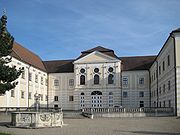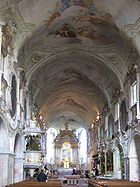
Geras Abbey
Encyclopedia


Premonstratensian
The Order of Canons Regular of Prémontré, also known as the Premonstratensians, the Norbertines, or in Britain and Ireland as the White Canons , are a Catholic religious order of canons regular founded at Prémontré near Laon in 1120 by Saint Norbert, who later became Archbishop of Magdeburg...
monastery in Geras in Lower Austria
Lower Austria
Lower Austria is the northeasternmost state of the nine states in Austria. The capital of Lower Austria since 1986 is Sankt Pölten, the most recently designated capital town in Austria. The capital of Lower Austria had formerly been Vienna, even though Vienna is not officially part of Lower Austria...
. Since 1783 it has also owned the premises of the former Pernegg Abbey nearby.
History
The abbey was founded in 1153 as a daughter house of Seelau Abbey by Ekbert and Ulrich of PerneggPernegg
Pernegg is a town in the district of Horn in Lower Austria, Austria....
and settled by canons from Seelau. Geras Abbey was able to survive the reforms of the Emperor Joseph II
Joseph II, Holy Roman Emperor
Joseph II was Holy Roman Emperor from 1765 to 1790 and ruler of the Habsburg lands from 1780 to 1790. He was the eldest son of Empress Maria Theresa and her husband, Francis I...
and the consequent monastery closures of 1783, and remains in operation to this day.
The abbey church is a Romanesque
Romanesque architecture
Romanesque architecture is an architectural style of Medieval Europe characterised by semi-circular arches. There is no consensus for the beginning date of the Romanesque architecture, with proposals ranging from the 6th to the 10th century. It developed in the 12th century into the Gothic style,...
basilica
Basilica
The Latin word basilica , was originally used to describe a Roman public building, usually located in the forum of a Roman town. Public basilicas began to appear in Hellenistic cities in the 2nd century BC.The term was also applied to buildings used for religious purposes...
which was reworked in the Baroque
Baroque architecture
Baroque architecture is a term used to describe the building style of the Baroque era, begun in late sixteenth century Italy, that took the Roman vocabulary of Renaissance architecture and used it in a new rhetorical and theatrical fashion, often to express the triumph of the Catholic Church and...
style in the 18th century by the architect Josef Munggenast
Josef Munggenast
Josef Munggenast was an Austrian architect and masterbuilder of the Baroque period.Munggenast was born in Schnann in Tyrol, the nephew of Jakob Prandtauer, who advanced his career and whose influence marked his style for the whole of his life.From 1717 Munggenast was master mason in Sankt Pölten...
and the fresco
Fresco
Fresco is any of several related mural painting types, executed on plaster on walls or ceilings. The word fresco comes from the Greek word affresca which derives from the Latin word for "fresh". Frescoes first developed in the ancient world and continued to be popular through the Renaissance...
painter Paul Troger
Paul Troger
Paul Troger was an Austrian painter, draughtsman and printmaker of the late Baroque period. Troger's illusionistic ceiling paintings in fresco are notable for their dramatic vitality of movement and their palette of light colors.Paul Troger’s style, particularly in his frescoes, dominated Austrian...
.
In 1953 the church was given the title of Papal basilica.
Today the abbey is often used as a venue for classical music recitals.
Pernegg Abbey

Pernegg
Pernegg is a town in the district of Horn in Lower Austria, Austria....
, about 10 kilometres from Geras, Ekbert and Ulrich of Pernegg, the founders of Geras Abbey, also founded Pernegg Abbey, a Premonstratensian nunnery which was also a daughter house of Seelau Abbey.
Pernegg became a community of canons
Canon (priest)
A canon is a priest or minister who is a member of certain bodies of the Christian clergy subject to an ecclesiastical rule ....
in 1584. In 1700 it became an abbey but was dissolved in 1783 under the reforms of Emperor Joseph II. In the mid-19th century the premises were acquired by Geras Abbey. Since 1995 they have been used as a retreat and seminar centre for the monastery at Geras.

